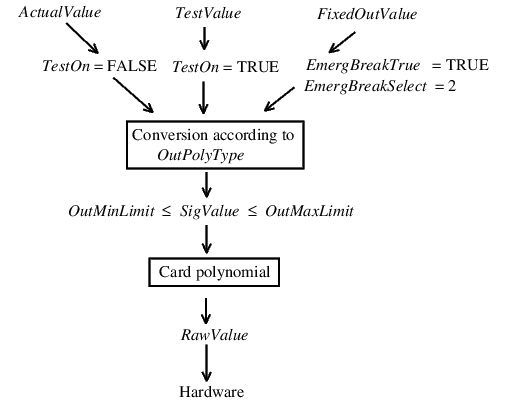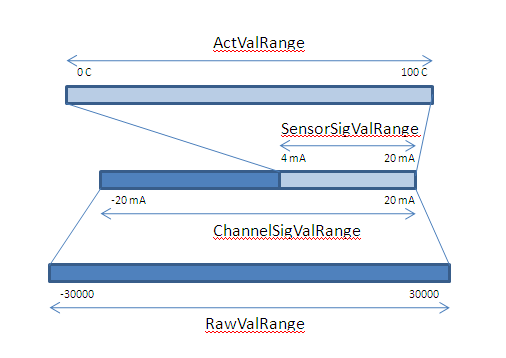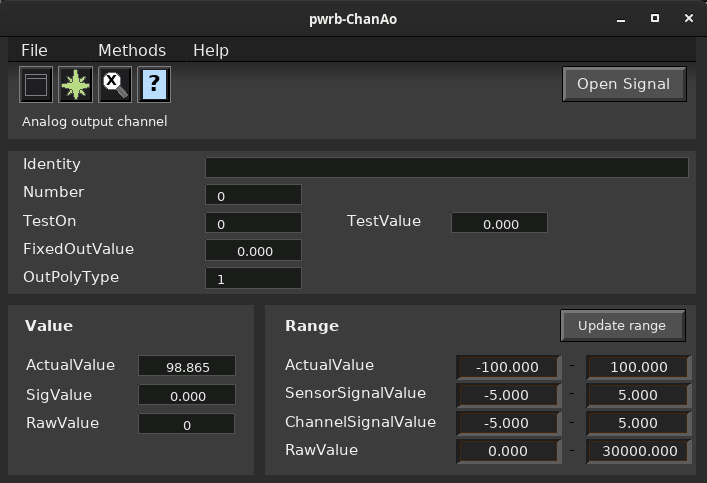
| Volume pwrb | |
| Attributes: Runtime | Development | System | Template | Detail C Binding: Struct | Class ClassTree | INDEX NO INDEX |
Class ChanAo
|
||
|---|---|---|
| Version | 1.0 | |
| Modified | 15-JAN-2025 13:23:36.00 | |
Configures an analog output channel independent of the type of physical Ao-card. Figure below shows the step in Ao-signal conversion. ActualValue SigValue and RawValue belong to the Ao object. The card polynomial is defined in a card object, the Emerg attributes in a $Node object, and the rest in the ChanAo object

Attributes Used in Ao-signal Conversion If EmergBreakTrue = TRUE and EmergBreakSelect = 2 then the output is based on FixedOutValue. Otherwise TestOn will settles which attribute the output is based on. For linear conversion, the conversion from engineering value to raw value can be specified by four ranges - raw value range RawValRangeLow - RawValRangeHigh - channel signal value range ChannelSigValRangeLow - ChannelSigValRangeHigh - sensor signal value range SensorSigValRangeLow - SensorSigValRangeHigh - actual value range ActValRangeLow - ActValRangeHigh

Hints
ChanAo objects are configured below a suitable card object. Rack and card objects to different I/O systems are documented separately. To create card object with channel objects belonging to it the function 'Configure Card' in "Utility Window" is recommended.Object graph

| RtBody attributes pwr_sClass_ChanAo | |||
|---|---|---|---|
| String80 | Description | Optional text, for example to describe the channel or its employment. |
|
| AttrRef | SigChanCon | Name of a signal object, i.e. Ao object, connected with the channel object. |
|
| String80 | Identity | The identity of the channel. Optional, for example Ao0 to denote the first channel, physical cable marking, etc. |
|
| UInt16 | Number | The Number attribute is used to associate the ChanAo object to a fixed channel on the card named by SigChanCon. The physical channels of the card are numbered in the interval {0,1, ... , (MaxNoOfChannels-1)} ,where MaxNoOfChannels is an attribute in the card object. The channels of the card are numbered according to the instructions of the card manufacturer. |
|
| Boolean | TestOn | Specifies if the output signal will be based on the ActualValue or the TestValue; see figure 3-4. FALSE means that ActualValue is used; TRUE means TestValue. |
|
| Float32 | TestValue | The output signal is based on the TestValue instead of ActualValue when TestOn is TRUE. |
|
| Float32 | FixedOutValue | Action value. The output signal is equal to FixedOutValue when EmergBreakTrue is TRUE and EmergBreakSelect = 2. The EmergBreak-attributes belong to the $Node object. |
|
| Boolean | CalculateNewCoef | ||
| UInt16 | OutPolyType | Specifies in which way the engineering value will be converted to SigValue. The possible types of conversions are: -- 0 No conversion: SigValue = ActualValue -- 1 Normal conversion according to the output signal polynomial: SigValue = OutPolyCoef0 + OutPolyCoef1 * ActualValue The attribute ActualValue belongs to an Ai object. |
|
| Float32 | OutPolyCoef0 | The constant term in a OutPolyType expression, see above. |
|
| Float32 | OutPolyCoef1 | Coefficient in an OutPolyType expression, see above. | |
| Float32 | ActValRangeLow | The Low and High values of ActValRange specifies the range of the ActualValue of the signal. These values are correlated to the SensorSigValRange. |
|
| Float32 | ActValRangeHigh | ||
| Float32 | SigValPolyCoef0 | ||
| Float32 | SigValPolyCoef1 | ||
| Float32 | SensorSigValRangeLow | The Low and High values of SensorSigValRange specifies the part of the ChannelSigValRange that is used by the sensor. For example, the channel can have a signal range of -20 - 20 mA but the sensor only utilizes 4 - 20 mA. |
|
| Float32 | SensorSigValRangeHigh | ||
| String16 | SigValueUnit | ||
| Float32 | ChannelSigValRangeLow | The Low and High values of ChannelSigValRange specifies the signal range of the channel. |
|
| Float32 | ChannelSigValRangeHigh | ||
| Float32 | RawValRangeLow | The Low and High values of RawValRange specifies the raw value range of the channel. |
|
| Float32 | RawValRangeHigh | ||
| DataRepEnum | Representation | Specifies the data representation of the raw value. | |
| RawValueTypeEnum | RawValueType | Raw value type, absolute or delta value. | |
| Template Object | |
|---|---|
| OutPolyType | 1 |
| ActValRangeLow | -100 |
| ActValRangeHigh | 100 |
| SensorSigValRangeLow | -5 |
| SensorSigValRangeHigh | 5 |
| ChannelSigValRangeLow | -5 |
| ChannelSigValRangeHigh | 5 |
| SigValueUnit | V |
| Description Attribute | ||
|---|---|---|
| Class | Attribute | |
| Type | String80 | |
| Flags | ||
| Body | RtBody | |
Optional text, for example to describe the channel or its employment.
| SigChanCon Attribute | ||
|---|---|---|
| Class | Attribute | |
| Type | AttrRef | |
| Flags | STATE | INVISIBLE | |
| Body | RtBody | |
Name of a signal object, i.e. Ao object, connected with the channel object.
| Identity Attribute | ||
|---|---|---|
| Class | Attribute | |
| Type | String80 | |
| Flags | ||
| Body | RtBody | |
The identity of the channel. Optional, for example Ao0 to denote the first channel, physical cable marking, etc.
| Number Attribute | ||
|---|---|---|
| Class | Attribute | |
| Type | UInt16 | |
| Flags | ||
| Body | RtBody | |
The Number attribute is used to associate the ChanAo
object to a fixed channel on the card named by
SigChanCon. The physical channels of the card are
numbered in the interval {0,1, ... , (MaxNoOfChannels-1)}
,where MaxNoOfChannels is an attribute in the card
object.
The channels of the card are numbered according to the
instructions of the card manufacturer.
| TestOn Attribute | ||
|---|---|---|
| Class | Attribute | |
| Type | Boolean | |
| Flags | STATE | |
| Body | RtBody | |
Specifies if the output signal will be based on the ActualValue or the TestValue; see figure 3-4. FALSE means that ActualValue is used; TRUE means TestValue.
| TestValue Attribute | ||
|---|---|---|
| Class | Attribute | |
| Type | Float32 | |
| Flags | STATE | |
| Body | RtBody | |
The output signal is based on the TestValue instead of ActualValue when TestOn is TRUE.
| FixedOutValue Attribute | ||
|---|---|---|
| Class | Attribute | |
| Type | Float32 | |
| Flags | ||
| Body | RtBody | |
Action value. The output signal is equal to FixedOutValue when EmergBreakTrue is TRUE and EmergBreakSelect = 2. The EmergBreak-attributes belong to the $Node object.
| CalculateNewCoef Attribute | ||
|---|---|---|
| Class | Attribute | |
| Type | Boolean | |
| Flags | ||
| Body | RtBody | |
| OutPolyType Attribute | ||
|---|---|---|
| Class | Attribute | |
| Type | UInt16 | |
| Flags | ||
| Body | RtBody | |
Specifies in which way the engineering value will be
converted to SigValue. The possible types of
conversions are:
-- 0 No conversion: SigValue = ActualValue
-- 1 Normal conversion according to the output signal polynomial:
SigValue = OutPolyCoef0 + OutPolyCoef1 * ActualValue
The attribute ActualValue belongs to an Ai object.
| OutPolyCoef0 Attribute | ||
|---|---|---|
| Class | Attribute | |
| Type | Float32 | |
| Flags | ||
| Body | RtBody | |
The constant term in a OutPolyType expression, see above.
| OutPolyCoef1 Attribute | ||
|---|---|---|
| Class | Attribute | |
| Type | Float32 | |
| Flags | ||
| Body | RtBody | |
Coefficient in an OutPolyType expression, see above.
| ActValRangeLow Attribute | ||
|---|---|---|
| Class | Attribute | |
| Type | Float32 | |
| Flags | ||
| Body | RtBody | |
The Low and High values of ActValRange specifies the range of the ActualValue of the signal. These values are correlated to the SensorSigValRange.
| ActValRangeHigh Attribute | ||
|---|---|---|
| Class | Attribute | |
| Type | Float32 | |
| Flags | ||
| Body | RtBody | |
| SigValPolyCoef0 Attribute | ||
|---|---|---|
| Class | Attribute | |
| Type | Float32 | |
| Flags | INVISIBLE | STATE | |
| Body | RtBody | |
| SigValPolyCoef1 Attribute | ||
|---|---|---|
| Class | Attribute | |
| Type | Float32 | |
| Flags | INVISIBLE | STATE | |
| Body | RtBody | |
| SensorSigValRangeLow Attribute | ||
|---|---|---|
| Class | Attribute | |
| Type | Float32 | |
| Flags | ||
| Body | RtBody | |
The Low and High values of SensorSigValRange specifies the part of the ChannelSigValRange that is used by the sensor. For example, the channel can have a signal range of -20 - 20 mA but the sensor only utilizes 4 - 20 mA.
| SensorSigValRangeHigh Attribute | ||
|---|---|---|
| Class | Attribute | |
| Type | Float32 | |
| Flags | ||
| Body | RtBody | |
| SigValueUnit Attribute | ||
|---|---|---|
| Class | Attribute | |
| Type | String16 | |
| Flags | ||
| Body | RtBody | |
| ChannelSigValRangeLow Attribute | ||
|---|---|---|
| Class | Attribute | |
| Type | Float32 | |
| Flags | ||
| Body | RtBody | |
The Low and High values of ChannelSigValRange specifies the signal range of the channel.
| ChannelSigValRangeHigh Attribute | ||
|---|---|---|
| Class | Attribute | |
| Type | Float32 | |
| Flags | ||
| Body | RtBody | |
| RawValRangeLow Attribute | ||
|---|---|---|
| Class | Attribute | |
| Type | Float32 | |
| Flags | ||
| Body | RtBody | |
The Low and High values of RawValRange specifies the raw value range of the channel.
| RawValRangeHigh Attribute | ||
|---|---|---|
| Class | Attribute | |
| Type | Float32 | |
| Flags | ||
| Body | RtBody | |
| Representation Attribute | ||
|---|---|---|
| Class | Attribute | |
| Type | DataRepEnum | |
| Flags | ||
| Body | RtBody | |
Specifies the data representation of the raw value.
| RawValueType Attribute | ||
|---|---|---|
| Class | Attribute | |
| Type | RawValueTypeEnum | |
| Flags | ||
| Body | RtBody | |
Raw value type, absolute or delta value.